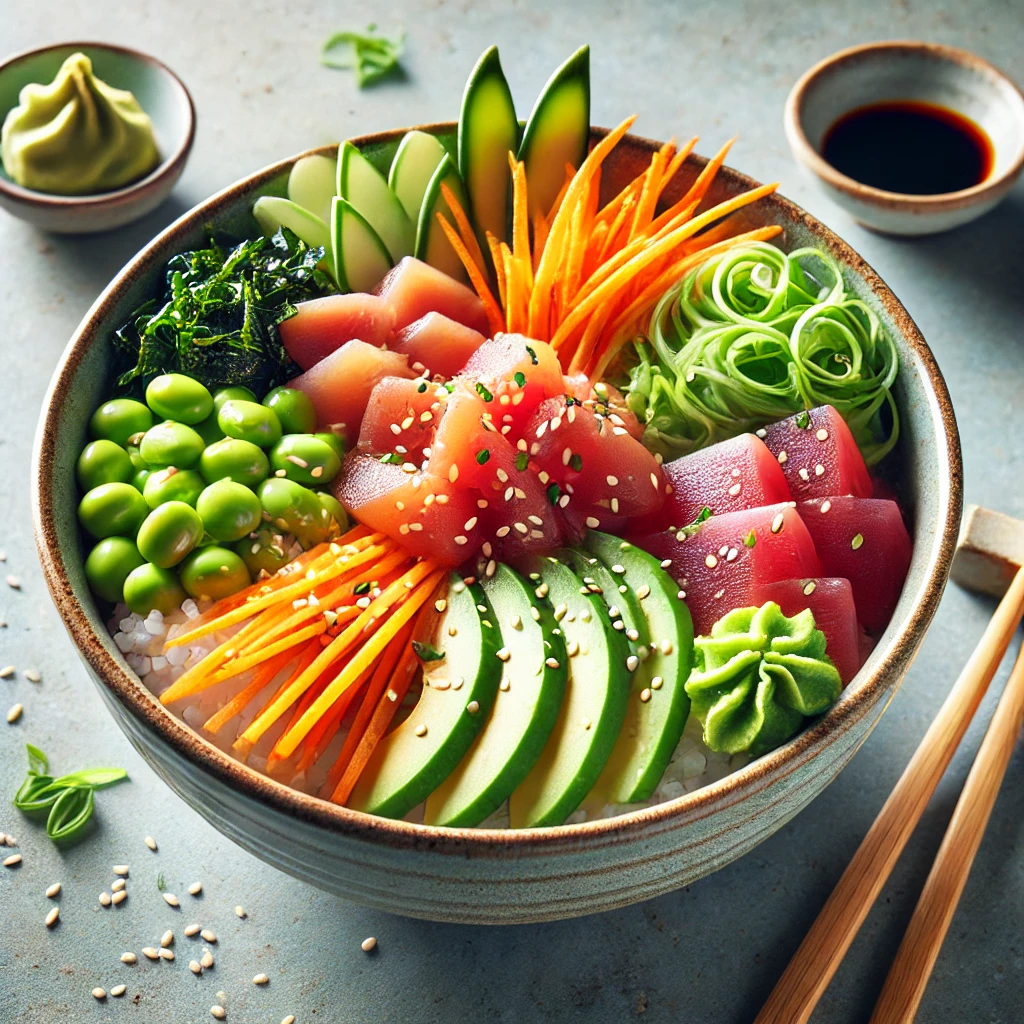Sushi has long been celebrated as a culinary art form that combines taste, texture, and visual appeal. Originating in Japan, sushi has become a global phenomenon, with various adaptations and interpretations. One such delightful variation is the Sushi Bowl—a deconstructed version of the classic sushi roll that is not only easier to make but also offers endless customization possibilities. In this blog post, we’ll dive into the world of Sushi Bowls, exploring their origins, how to make them, and why they have become a favorite among food enthusiasts.
The Origins of Sushi Bowls
Sushi, in its traditional form, is a labor-intensive dish that requires skill and precision. It involves the meticulous preparation of vinegared rice, the careful selection of fresh fish, and the artful assembly of ingredients into bite-sized rolls or nigiri. While this traditional form of sushi remains beloved, the Sushi Bowl emerged as a response to the desire for a quicker, more accessible way to enjoy the flavors of sushi.
The concept of the Sushi Bowl can be traced back to the poke bowl, a Hawaiian dish that consists of marinated raw fish served over rice and topped with various vegetables and seasonings. As poke gained popularity worldwide, it inspired similar dishes, including the Sushi Bowl, which offers a similar experience but with the distinct flavors and ingredients associated with sushi.
Why Sushi Bowls?
Sushi Bowls have rapidly gained popularity for several reasons:
- Simplicity: Unlike traditional sushi, which requires careful rolling and cutting, Sushi Bowls are straightforward to assemble. You don’t need specialized skills or tools to create a beautiful and delicious dish.
- Customization: One of the greatest appeals of Sushi Bowls is the ability to customize them according to your taste. You can mix and match your favorite ingredients, from various types of fish to a wide array of vegetables, sauces, and toppings.
- Healthy and Nutritious: Sushi Bowls are typically made with fresh, wholesome ingredients. You can control the portion sizes and choose healthier options, making it an excellent meal choice for those looking to maintain a balanced diet.
- Convenience: Sushi Bowls are perfect for meal prepping. You can prepare the ingredients in advance, store them separately, and assemble your bowl when you’re ready to eat.
- Variety: With Sushi Bowls, the possibilities are endless. Whether you prefer a traditional combination of tuna and avocado or something more adventurous like smoked salmon with mango, there’s a Sushi Bowl recipe for everyone.
How to Make a Sushi Bowl
Now that we’ve covered the basics, let’s move on to the exciting part—making your own Sushi Bowl! Here’s a step-by-step guide to creating a delicious and satisfying Sushi Bowl at home.
Ingredients:
- Sushi Rice: The base of your bowl. Sushi rice is short-grain rice seasoned with a mixture of rice vinegar, sugar, and salt. This gives it the distinctive flavor and texture associated with sushi.
- Protein: The star of your Sushi Bowl. Choose from raw fish like tuna, salmon, or yellowtail, or opt for cooked options like shrimp, crab, or tofu for a vegetarian alternative.
- Vegetables: Add color, crunch, and nutrition to your bowl with vegetables like cucumber, avocado, radishes, edamame, and carrots.
- Seaweed: Nori (dried seaweed) is a common sushi ingredient that can be sliced into thin strips or crumbled over your bowl.
- Sauces: Drizzle your bowl with soy sauce, spicy mayo, ponzu, or any other sauce you love. These sauces add flavor and moisture to the dish.
- Toppings: Enhance the texture and flavor of your Sushi Bowl with toppings like sesame seeds, pickled ginger, wasabi, and green onions.
Step-by-Step Instructions:
- Cook the Rice: Start by preparing the sushi rice. Rinse the rice under cold water until the water runs clear. Cook the rice according to the package instructions. Once cooked, transfer the rice to a large bowl and gently fold in the rice vinegar, sugar, and salt. Let the rice cool to room temperature.
- Prepare the Protein: If you’re using raw fish, ensure it’s of sushi-grade quality. Slice the fish into thin pieces or cubes. If you prefer cooked protein, prepare it according to your taste.
- Chop the Vegetables: While the rice is cooling, chop your chosen vegetables into bite-sized pieces. Thinly slice the avocado, julienne the cucumber, and cut the carrots into matchsticks.
- Assemble the Bowl: Once the rice has cooled, scoop a generous portion into a bowl. Arrange your protein on top of the rice, followed by the vegetables. Be creative with your presentation—layer the ingredients in a visually appealing way.
- Add Seaweed: Cut the nori into thin strips or crumble it over the top of your bowl. This adds a hint of the ocean’s flavor to your dish.
- Drizzle the Sauce: Choose your favorite sauce(s) and drizzle them over the top of your bowl. Spicy mayo is a popular choice for a kick of heat, while soy sauce adds a salty, umami flavor.
- Top It Off: Finish your Sushi Bowl with a sprinkle of sesame seeds, a dollop of wasabi, pickled ginger, or any other toppings you enjoy.
- Enjoy!: Your Sushi Bowl is ready to be enjoyed. Mix everything together to combine the flavors, or savor each bite individually.
Variations and Tips
Sushi Bowls are incredibly versatile, allowing you to tailor them to your preferences. Here are a few ideas to inspire your next creation:
- Spicy Tuna Bowl: Mix diced tuna with spicy mayo and sriracha. Serve over sushi rice with avocado, cucumber, and a drizzle of soy sauce.
- California Roll Bowl: Use imitation crab meat, avocado, and cucumber. Top with sesame seeds and a squeeze of lemon juice.
- Vegan Sushi Bowl: Substitute fish with tofu or tempeh. Add edamame, avocado, cucumber, and carrots. Drizzle with a soy-based sauce or a sesame-ginger dressing.
- Rainbow Bowl: Combine a variety of fish like tuna, salmon, and yellowtail. Add colorful vegetables like red cabbage, bell peppers, and mango for a vibrant dish.
- Smoked Salmon Bowl: Use smoked salmon instead of raw fish. Pair with cream cheese, capers, red onion, and cucumber for a bagel-inspired Sushi Bowl.
Tips for Success:
- Quality Ingredients: Since Sushi Bowls are simple, the quality of ingredients matters. Choose the freshest fish and vegetables you can find.
- Sushi-Grade Fish: If you’re using raw fish, make sure it’s labeled as sushi-grade, meaning it’s safe to eat raw.
- Rice Perfection: The rice should be sticky but not mushy. Properly seasoning the rice with vinegar, sugar, and salt is crucial for authentic sushi flavor.
- Balancing Flavors: A good Sushi Bowl balances flavors—sweet, salty, tangy, and spicy. Don’t be afraid to experiment with
Sushi Bowls have become a trendy dish in recent years, appearing on menus at restaurants and food trucks around the world. Their popularity can be attributed to the growing interest in healthy, flavorful, and customizable meals. Sushi Bowls cater to a wide range of dietary preferences, including gluten-free, vegetarian, and keto options.
Social media has also played a significant role in the rise of Sushi Bowls. Their vibrant colors and artful presentation make them highly Instagrammable, encouraging food enthusiasts to share their creations online. This has further fueled the popularity of Sushi Bowls, inspiring people to try making them at home.
Conclusion
Sushi Bowls offer a delightful way to enjoy the flavors of sushi without the complexity of traditional sushi-making. They are a versatile, healthy, and visually appealing dish that can be customized to suit any palate. Whether you’re a seasoned sushi lover or new to the world of Japanese cuisine, Sushi Bowls provide a fun and satisfying meal that’s sure to impress.
So why not give it a try? Gather your favorite ingredients, follow the simple steps outlined above, and create your own Sushi Bowl masterpiece. It’s a culinary adventure you won’t want to miss!






